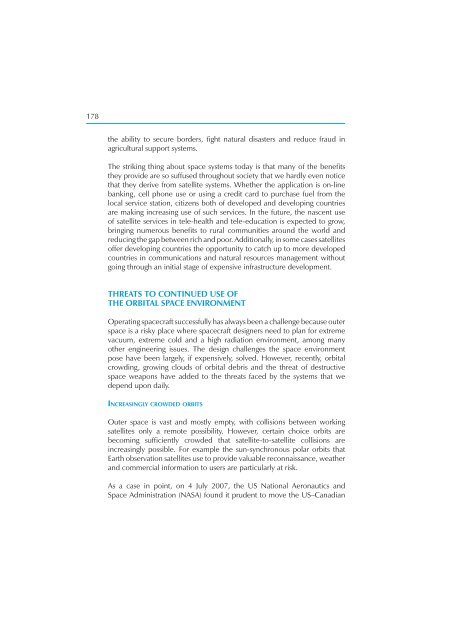Security in Space The Next Generation - UNIDIR
Security in Space The Next Generation - UNIDIR
Security in Space The Next Generation - UNIDIR
You also want an ePaper? Increase the reach of your titles
YUMPU automatically turns print PDFs into web optimized ePapers that Google loves.
178<br />
the ability to secure borders, fi ght natural disasters and reduce fraud <strong>in</strong><br />
agricultural support systems.<br />
<strong>The</strong> strik<strong>in</strong>g th<strong>in</strong>g about space systems today is that many of the benefi ts<br />
they provide are so suffused throughout society that we hardly even notice<br />
that they derive from satellite systems. Whether the application is on-l<strong>in</strong>e<br />
bank<strong>in</strong>g, cell phone use or us<strong>in</strong>g a credit card to purchase fuel from the<br />
local service station, citizens both of developed and develop<strong>in</strong>g countries<br />
are mak<strong>in</strong>g <strong>in</strong>creas<strong>in</strong>g use of such services. In the future, the nascent use<br />
of satellite services <strong>in</strong> tele-health and tele-education is expected to grow,<br />
br<strong>in</strong>g<strong>in</strong>g numerous benefi ts to rural communities around the world and<br />
reduc<strong>in</strong>g the gap between rich and poor. Additionally, <strong>in</strong> some cases satellites<br />
offer develop<strong>in</strong>g countries the opportunity to catch up to more developed<br />
countries <strong>in</strong> communications and natural resources management without<br />
go<strong>in</strong>g through an <strong>in</strong>itial stage of expensive <strong>in</strong>frastructure development.<br />
THREATS TO CONTINUED USE OF<br />
THE ORBITAL SPACE ENVIRONMENT<br />
Operat<strong>in</strong>g spacecraft successfully has always been a challenge because outer<br />
space is a risky place where spacecraft designers need to plan for extreme<br />
vacuum, extreme cold and a high radiation environment, among many<br />
other eng<strong>in</strong>eer<strong>in</strong>g issues. <strong>The</strong> design challenges the space environment<br />
pose have been largely, if expensively, solved. However, recently, orbital<br />
crowd<strong>in</strong>g, grow<strong>in</strong>g clouds of orbital debris and the threat of destructive<br />
space weapons have added to the threats faced by the systems that we<br />
depend upon daily.<br />
INCREASINGLY CROWDED ORBITS<br />
Outer space is vast and mostly empty, with collisions between work<strong>in</strong>g<br />
satellites only a remote possibility. However, certa<strong>in</strong> choice orbits are<br />
becom<strong>in</strong>g suffi ciently crowded that satellite-to-satellite collisions are<br />
<strong>in</strong>creas<strong>in</strong>gly possible. For example the sun-synchronous polar orbits that<br />
Earth observation satellites use to provide valuable reconnaissance, weather<br />
and commercial <strong>in</strong>formation to users are particularly at risk.<br />
As a case <strong>in</strong> po<strong>in</strong>t, on 4 July 2007, the US National Aeronautics and<br />
<strong>Space</strong> Adm<strong>in</strong>istration (NASA) found it prudent to move the US–Canadian








